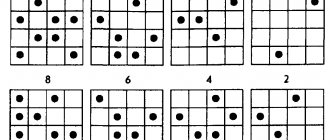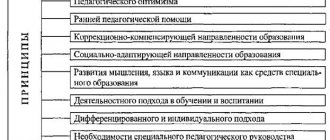22.03.2017
Mental retardation is understood as a lag in the development of mental mechanisms, as well as the immaturity of the emotional and volitional activity of children, which can be overcome with the help of specialized training and upbringing. Children with mental retardation are characterized by: insufficient development of memory, motor skills, thinking, speech, attention, and self-control. In addition, primitiveness and instability of emotions and poor performance at school are noted. Diagnosis of mental retardation must be carried out jointly by a commission, which includes, in addition to medical specialists, psychologists and teachers. Children with established mental retardation need, along with medical care, specially organized correctional and developmental education.
Mental retardation is a reversible disorder of the emotional-volitional as well as intellectual sphere, which is accompanied by certain difficulties in the learning process. About 15-16% of children have some degree of mental retardation. Mental retardation is most often attributed to psychological and pedagogical problems, but it can also be based on organic abnormalities, in particular neurological diseases. Various mental functions in children develop unevenly, so it is often impossible to diagnose children until they reach 4-5 years of age. In practice, the diagnosis is established mainly already at school age.
Causes of mental retardation
Mental retardation may be based on socio-psychological or biological factors. Biological factors lead to disruption of the formation of various parts of the brain, which is accompanied by partial deviations in the child’s mental maturation. The influence can be exerted by factors acting during pregnancy (fetal hypoxia, severe toxicosis, gestosis, Rh conflict, intrauterine infection, etc.), during childbirth and after the birth of a child (intracranial trauma, kernicterus of newborns). In early childhood, mental retardation can be caused by severe somatic and infectious diseases, and traumatic brain injuries.
Another group of reasons includes environmental (social) factors. There is no organic damage to the brain. The reason may be neglect on the part of parents, or excessive guardianship, social deprivation, authoritarian upbringing, or lack of contact with adults and peers.
Delayed mental development of secondary origin is often caused by early visual and hearing impairment, speech defects due to a pronounced lack of sensory information and communication.
Types of mental retardation
Thus, groups of children with mental retardation are heterogeneous. There are several classifications of mental retardation. Let's consider the etiopathogenetic classification, which distinguishes 4 clinical types of mental retardation.
- ZPR of constitutional origin is caused by the slow maturation of the central nervous system. It is characterized by harmonious physical and mental infantilism. The behavior and anthropometric data of children do not correspond to their age. They are emotionally labile, spontaneous, there is an inability to concentrate, lack of memory. At school age, such children have more playful than educational interests.
- ZPR of somatogenic origin is caused by long-term severe somatic diseases of children at an early age, which inevitably delay the maturation and formation of the central nervous system. Children's medical history includes chronic diseases of the respiratory system, gastrointestinal tract, cardiovascular system, kidneys, etc. As a rule, children spend a long time in hospitals, isolated from their peers. ZPR of somatogenic genesis can manifest itself in the form of asthenic syndrome, low performance in children, decreased memory, superficial attention, hyperactivity or lethargy due to overwork.
- Mental retardation of psychogenic origin is caused by negative social conditions in which the child is forced to be (neglect, abuse, overprotection). Due to attention deficit, a child may develop mental instability, intellectual retardation, and impulsiveness. With excessive guardianship, lack of will, lack of initiative, lack of purposefulness, and egocentrism are formed.
- ZPR of cerebral-organic origin occurs quite often. It may be caused by mild organic damage to the brain. There may be damage to one area or mosaic damage to several areas of the brain, disrupting one or more mental functions. Delayed mental development of cerebral-organic origin can be characterized as unformed emotional-volitional side and cognitive work: lack of brightness and liveliness of emotions, pronounced suggestibility, poverty of imagination, motor disinhibition, etc.
Delays in mental development are borderline conditions with mental retardation (oligophrenia), i.e., intermediate forms of intellectual deficiency between debility and the norm.
Mental development delays associated with immaturity of the psyche and brain structures are considered as separate groups of conditions with developmental pathology (this is how they were interpreted in ICD-8 and ICD-9) or as a syndrome included in the structure of one or another neurological, mental or somatic disease (ICD-10).
The prevalence of mental retardation in the child population (as an independent group of conditions) is 1.2% and 8-10% in the overall structure of mental illness. Mental development delays, naturally, are much more common as a syndrome.
Mental disorders with mental retardation manifest themselves in the form of a lag in the development of various spheres of mental activity - motor, cognitive, emotional-volitional, speech from an early age due to a slowdown in the maturation of the corresponding brain structures.
Diagnosis of mental retardation is possible from the first months of life. In some cases, a delay in the development of the emotional sphere comes to the fore, in others a delay in the development of intelligence in the form of borderline mental retardation predominates. The latter is sometimes combined with signs of underdevelopment of the frontal and parietal lobes of the brain on the EEG [Blagosklonova N. K. .et al., 1994].
Delay in the maturation of mental functions can vary from mild to severe. With a mild degree of mental retardation, the development of age-related skills is delayed within one age period; with an average degree, the development of age-related motor and speech skills, emotional reactions, manual skills, communicative interactions and other neuropsychic functions is delayed by more than one age period; in severe cases, the lag in the acquisition of age-related skills exceeds two age periods.
With a mild degree of mental retardation, signs of compensation for the lagging function are also revealed. With moderate developmental delay and a continuing tendency towards compensation, the timing of the development of mental functions lags significantly behind the standards. A severe degree of developmental delay, as a rule, does not contain elements of compensation in its structure, and mental retardation is characterized not only by retardation, but also by various kinds of anomalies. This type of psychomotor developmental delay usually reflects the consequences of prenatal or intrapartum brain damage, and these cases are the most difficult in differential diagnostic terms, especially in terms of distinguishing from mental retardation.
The main clinical signs of mental retardation (according to M. Sh. Vrono): delayed development of basic psychophysical functions (motor skills, speech, social behavior); emotional immaturity; uneven development of individual mental functions; functional, reversible nature of the disorders.
Etiological factors of mental development delays are divided into constitutional-genetic, cerebral-organic and psychosocial. Some congenital and hereditary progressive diseases of the nervous system in the first years of life also manifest themselves as delayed psychomotor development, but in these cases we are talking about a corresponding syndrome, the dynamics of which are determined by the main disease process. In some cases of mild degrees of mental retardation, the noted disturbances in the process of subsequent development of the child disappear and the diagnosis of retardation of mental functions is removed.
There are primary and secondary delays in mental development [Zhurba L. T., 1980; Lebedev B.V., 1981; Maslova O I, 1991; Goryunova A V, 1994]. Primary delays
cerebral-organic origin are the most common developmental disorders.
They are based on hypoxic, traumatic, infectious, toxic and other factors acting on the developing brain in the perinatal period (birth trauma, asphyxia, early infections, prematurity, some hereditary diseases, endocrinopathies, etc.), leading to mild brain damage, not reaching a clear organic defect. Secondary delays
in neuropsychic development occur against the background of a primarily intact brain in chronic somatic diseases (for example, heart defects), accompanied by cerebral insufficiency in the form of minimal brain dysfunction. Metabolic disorders and associated toxic and hypoxic effects in chronic somatic diseases, combined with instability in the regulation of homeostasis, especially at an early age, lead to damage to the nervous system and suspension of psychophysical development. A distinctive feature of secondary mental retardation is the presence in their structure of affective disorders and delayed formation of positive emotional reactions. In these cases, against the background of low emotional tone, there is a lag in adequate forms of communication with adults, the emotional and playful nature of communications does not develop for a long time, there are no imitative gestures, adequate facial expressions, and the initial stages of speech development are delayed. The exit from these states is often abrupt through the accelerated development of delayed functions.
A special variant of the disorder is delayed development with dissociation
(splitting) and
disharmony
(unevenness) of the development of individual mental functions. The most characteristic of this variant is the combination of uneven delay of mental functions with autism. This variant of mental retardation is a harbinger of future mental pathology (autism, childhood schizophrenia, etc.).
In some forms of mental retardation, a large place in the clinical picture is occupied by neurological disorders with hyperexcitability, hypertensive, hydrocephalic, convulsive and cerebroasthenic phenomena, as well as muscle hypotonia, etc. In other cases, intellectual development lag predominates. The latter must be distinguished from defective states that occur as a result of mental illnesses (primarily childhood schizophrenia and the consequences of organic brain diseases).
Children's neurologists [Zhurba L. T., Mastyukova E. M., 1981] introduced the concept of nonspecific, or benign, developmental delay, which is caused by a slowdown in the rate of maturation of the morpho-functional structures of the brain, and specific delay, which is caused by brain damage.
In the first years of life, due to the immaturity of the nervous system, children often experience dysfunction in the maturation of motor and general mental functions. Therefore, usually in early childhood we are talking about a general delay in psychomotor development with a greater severity of mental function lag. In children older than 3 years, it becomes possible to identify more defined psychoneurological syndromes.
It is justified to attribute (L. T. Zhurba, E. M. Mastyukova) mental development disorders to secondary delays (without an initial cerebral organic defect) in some forms of vision and hearing pathology, after a severe and prolonged psychotraumatic situation, with educational defects, especially in conditions of deprivation, etc. Recent studies in the field of mental deprivation, especially sensory (blindness, deafness) and as a result of orphanhood, show that the severity of deprivation-related developmental delays depends on the age of the child. If the corresponding factor acts from the first months of life, then it directly affects the nervous system. But in cases where blindness and deafness are congenital, they themselves already reflect the pathology of the brain, i.e. in these cases we are talking about primary cerebral pathology [Langmeyer I., Mateichik 3., 1984; Kalinina M. A., 1995; Proselkova M. E., Kozlovskaya G. V., 1995; Stroganova T. A., 1995, etc.].
There is a division of mental development delays into total,
in which the maturation of motor and mental functions lags behind more or less evenly, and
partial,
when the lag in the development of any one function comes to the fore.
The term “total delay” is more often used in relation to deep degrees of mental retardation, and for borderline forms the term “partial delay” is more often used.
Partial delays are usually caused by the physiological phenomenon of brain heterochrony mentioned above, i.e., non-simultaneous maturation of brain structures, which creates the possibility of disproportionality and asynchrony in the development of certain functions, including delays in their formation. The most obvious example is various variants of partial delay in motor or speech development. Among them are motor alalia, dyslalia
and
dysarthria, dyspraxia
in early and preschool age, which later act as
dysgraphia, dyscalculia
and
dyslexia.
When motor space is limited (immobilization), there is a lag in the formation of stato-kinetic functions, while mental and speech functions are developed normally, and sometimes even to a greater extent. Similar relationships develop with a deficit of visual-auditory and cognitive stimuli.
A partial form of psychomotor development delay includes a delay in the development of expressive and impressive speech.
or their mixed forms, which is especially common in early childhood. This is due to the fact that in children of the first years of life, with different maturation times of brain structures that provide the complex integrative function of speech, there is a basis for a physiological discrepancy between semantic, semantic and speech motor functions. In the absence of optimal speech contact, this causes the appearance of various speech disorders. Speech delay at the pre-speech stage consists of the late appearance of intonation expressiveness of a cry, poverty and rarity of vocal reactions, the absence or late appearance of the first babbling words and sound combinations, the first words, the first phrases. These deviations can occur against the background of timely formation of internal speech, but are usually combined with a delay in the semantic aspect of speech. In some cases, they indicate a violation of only the motor component of speech, while in others they indicate disorders of sensory perception, phonemic hearing, gnosis and are early signs of integrative disorders of higher mental functions - reading, writing, counting.
Age-related characteristics of mental development delays are characterized by a return to the previous level of development, i.e., the previous age period.
Thus, in the first year of life there may be a delay in the formation of motor functions, the extinction of some unconditioned reflexes and the formation of attitudinal, chain symmetrical and asymmetrical reflexes of position and straightening. The formation of such motor acts as holding the head, turning the body, sitting, standing, crawling, walking, etc. is slow and often inconsistent. The development of integrative psychomotor, i.e., purposeful, conscious motor acts, is also lagging behind. If we are talking about children in the second half of life, then usually such deviations as late fixation of gaze, poor tracking of objects, lag in visual-motor coordination, decreased cognitive interests, and insufficiency of pre-speech stages of speech become obvious. The immaturity of the emotional-volitional sphere is expressed in the late appearance of a smile and the complex of revival, in the delay in the differentiation of emotional reactions to the environment, in changes in general mental activity.
In the 2nd year of life, with continued delay in static and kinetic functions, insufficiency of cognitive activity and speech comes to the fore. This is manifested in a decrease in indicative reactions of attention and research interest, in the absence or insufficiency of imitation, lethargy of play activity, difficulty acquiring self-care skills, insufficient understanding of addressed speech and a delay in the appearance of the first words.
If the delay in psychomotor development does not regress by the age of 3, then a lag in speech functions, a lack of cognitive and play activity, and unformed age-related forms of behavior are typical during this period. Phrasal speech is absent or poor with agrammatisms and incorrect pronunciation, there is no speech imitation. It is difficult to master self-service skills. The game remains primitive, there is no complication or it is slow. The stock of age-related information and skills is insufficient, weakness of primary generalizations is observed, there is no identification of gender, the ability to identify essential features of objects, there is no differentiated interest in intellectual forms of play. Motor functions may remain immature, and dyspraxic deviations are pronounced.
There is a point of view according to which the clinical picture of mental development delays is determined by the forms of neuropsychic response inherent in different age periods. Thus, V.V. Kovalev (1988) identifies the following levels of age-related response: somatovegetative - in children from birth to 3 years, psychomotor - from 4 to 7 years, affective - from 5 to 10 years, emotional-ideational - from 11 to 17 years. Although this division is naturally somewhat artificial, it allows us to understand many features of childhood psychopathology. In recent years, new complexes of various mental symptoms and syndromes have been identified in this area, which have their own general patterns, observed in early childhood and little described in general psychiatry.
Based on the main risk factors for the development of mental dysontogenesis according to V.V. Kovalev, mental development delays can be divided into 3 clinical groups: 1) typical developmental delay of undifferentiated genesis, in which there is uniform or partial retardation in general or individual mental functions against the background of neurological symptoms of minimal or no brain dysfunction. This form is easily reversible and mild; 2) mental retardation of the cerebral-organic type, characterized by the severity of developmental disorders (moderate and greater degrees), combination with neurological symptoms and partial reversibility of deviations; 3) delayed mental development of deprivation genesis due to sensory deprivation (in the blind and deaf) and maternal emotional, cognitive, microsocial, etc. deprivation (in orphans). The last two forms of mental development disorders have been studied in particular detail in recent years. In conditions of blindness and deafness from the first years of life, children experience a special form of mental retardation (with simultaneous disharmony, dysrhythmia and developmental distortions) in the form of a “maladaptation syndrome” that develops at an early age and reaches its greatest severity during the first age crisis (2 .5-3.5 years), which is subsequently transformed into a special development of the personality of the deficit type [Kozlovskaya G.V., 1971; Matveev V.F., Bardenshtein L.M., 1975; Stroganova T. A., 1994]. Similar features were noted in orphans raised in orphanages from the first year of life. They also showed characteristic delays in mental development with a violation of not only the pace, but also the sequence of stages of development, with distinct emotional (depressive) reactions and communication disorders in the form of deprivation paraautism. By the age of 3-3.5 years, orphans from birth develop orphan syndrome (depression, paraautism, motor stereotypies, etc.), which by pre- and puberty develops into characteristic deficient personality development [Bashina V.M., Proselkova M. E., Kozlovskaya G. V., 1996; Kalinina M.A. et al., 1997].
The mental development delays considered are characterized by the reversibility of many disorders, i.e., a relatively favorable prognosis. In some cases, such a delay can be completely eliminated through an accelerated phase of maturation - a leap in development or through delayed development; in others, some underdevelopment of a particular function may remain or compensation occurs with other, sometimes accelerated, functions. In some cases, manifestations of minimal brain dysfunction syndrome and disorders such as hyperkinetic syndrome (attention deficit disorder) and specific disorders of school skills remain. Delayed mental development in childhood can also become the basis for pathocharacterological disorders of personality development.
Distinctive features of children with mental retardation
Intellectual impairments in children with mental retardation are characterized by a mild nature, but can affect all aspects of intellectual activity: speech, perception, thinking, memory, attention.
A child with mental retardation has fragmented, inaccurate, slow perception. Some analyzers function fully, but the child experiences difficulties in creating holistic images of the environment. Visual perception is the most developed, auditory perception is less developed; therefore, when explaining academic disciplines to children with mental retardation, it is necessary to use visual materials.
Children with mental retardation have unstable, superficial, short-term attention. The child is distracted and switches attention under the influence of any extraneous stimuli. Situations that involve concentration, concentrating on something, can cause difficulties. With overwork and increased tension, signs of hyperactivity syndrome, as well as attention deficit, may be detected.
Memory is characterized by patchy memorization of information and poor selectivity. Visual-figurative memory prevails over verbal. Characterized by low mental activity in the process of reproducing information. Children with mental retardation have more intact visual and effective thinking; Figurative thinking is more impaired due to inaccuracy of perception. Abstract logical thinking cannot be achieved without the help of adults. Children with mental retardation are characterized by difficulties with synthesis and analysis, comparison, and generalization; they are not able to organize events, build inferences, or formulate conclusions. In addition, children with mental retardation have distorted articulation of most sounds, damage to auditory differentiation, and a sharp limitation of vocabulary.
The difference between mental retardation and mental retardation
Differential diagnosis of these two conditions can be carried out from 5-5.5 years. That is, it turns out that up to 5 years of age, doctors (neurologists, psychiatrists) in practice write “CPR” in the conclusion, and then a diagnosis is made (remember that, according to the current international classification of diseases, CPR is not a medical diagnosis).
In order to reliably separate MR from ZPR, it is necessary to conduct a diagnosis using the Wechsler children's test. There are other diagnostic tools that help to “measure” the degree and structure of mental retardation, but at the moment only according to Wechsler there is a clear gradation: with UL the child scores less than 69 points. In this case, it is optimal to conduct testing at the age of about 8 years. Both in practice and according to the test results, there is a “layer” of children who have a fairly severe developmental delay on a cerebral-organic basis, but nevertheless do not yet belong to the category of developmental disabilities.
Differences between MA and ZPR in practice:
- A child with ID has no cognitive interest;
- Does not transfer the learned material to another similar one;
- After a break in classes, it’s “like a blank slate,” that is, what has been covered is very poorly absorbed and is not updated;
- The difference between the current level of development and biological age is more than 2 years;
- Children with ID do not develop abstract thinking;
- A child with mental retardation shows better dynamics and also successfully copes with tasks from the “zone of proximal development” with the help of an adult;
- Presenting the material in a playful manner improves the results of a child with mental retardation, while with mental retardation the child slips from the task into the game;
- Visual activity in children with mental retardation is, as a rule, better developed.
Diagnostics
To diagnose mental retardation, a comprehensive examination of the child is carried out by a special commission, which includes a child psychologist, speech therapist, child neurologist, defectologist, psychiatrist, pediatrician and, if necessary, other specialists. A history is collected and studied, a diagnostic examination of speech, a study of living conditions, neuropsychological testing, and an analysis of medical data. A conversation must be held with the child, intellectual processes and emotional and volitional qualities are examined.
When organic pathology is detected, an examination by medical specialists is necessary, first of all, a pediatric neurologist and pediatrician. During instrumental diagnostics, instrumental diagnostics can be performed - EEG, MRI of the brain. Differential diagnosis of mental retardation is carried out with autism and mental retardation.
Correction
To work with children suffering from mental retardation, a multidisciplinary approach is required, with the active participation of child psychologists, neurologists, pediatricians, speech therapists, psychiatrists, and speech pathologists. Correction of mental retardation should begin as early as possible, preferably in the preschool period.
Often children need to attend specialized preschool and general education institutions or special groups and correctional classes. It is necessary to dose the educational material, rely on clarity, frequent repetition of the material, and regularly change types of activities. It is important to pay attention to the development of various cognitive skills (thinking, attention, perception, memory), motor, sensory and emotional spheres, using play therapy and children's art therapy. Correction of speech apparatus disorders is carried out by a speech therapist.
When identifying somatic diseases and organic brain damage, massage, physiotherapy, hydrotherapy, exercise therapy.
Article on the topic “ZPR of somatogenic genesis”
Delayed mental development of somatogenic genesis occurs in children with chronic somatic diseases of the heart, kidneys, endocrine system, and the causes of this type of mental retardation are various chronic diseases, infections, childhood neuroses, congenital and acquired malformations of the somatic system. These reasons cause a delay in the development of children’s motor and speech functions, slow down the formation of self-care skills, and negatively affect the formation of subject-based play and elementary educational activities. Children with mental retardation of somatogenic origin are characterized by persistent physical and mental asthenia, which leads to decreased performance and the formation of personality traits such as timidity, timidity, anxiety, shyness, and lack of self-confidence. The child’s weakened body does not make it possible to carry out work at an even pace, as a result of which a child with mental retardation needs frequent changes of activities, switching of attention, and the creation of special conditions for carrying out certain activities. Under conditions of hypo- or hyperprotection, children often experience secondary infantilization and the formation of traits emotional and personal immaturity, etc.
Children in this category of mental retardation have little contact with their peers. When examining children with mental retardation of this type, special attention must be paid to the state of mental processes: memory, attention, thinking, as well as physical development (level of development of general and fine motor skills, coordination of movements, switchability, etc.). Since the weakened body of a child with mental retardation of somatogenic origin does not allow him to perform work at a smooth, planned pace, teachers and psychologists need to identify the moment of the child’s activity, determine the degree of load, create optimal conditions for compliance with the protective regime as in a preschool educational institution (kindergarten, orphanage ) and in the context of family education. Intellectual deficiency manifests itself in the inability to concentrate for a long time, in a decrease in memory, in a slowdown in the pace of mental activity. The level of speech development is markedly reduced: speech is poor and primitive. Children begin to speak later. As a rule, they have pronunciation defects, for example, agrammatism. In speech development - limited vocabulary, especially active vocabulary, slower acquisition of grammatical structure of speech, pronunciation defects, difficulties in mastering written language. With this type of mental retardation, children need treatment in special sanatoriums. The further development and education of these children depends on their health status.
Prevention
Children with mental retardation are able to catch up with their peers. They are trainable. With proper organization of correctional work, pronounced positive dynamics are observed in their development. Teachers help them master new knowledge and skills. They can also, like their peers, enter universities and colleges.
To prevent mental retardation in a child, it is necessary to take pregnancy planning with great responsibility, avoid negative effects on the fetus, prevent somatic and infectious diseases in children at an early age, and provide favorable living conditions for them. If a child is lagging behind in psychomotor development, immediate examination and the beginning of corrective work are necessary.








